| Banded Brothers | |
|---|---|
| Genre | |
| Narrated by | Dexter Fletcher |
| Country of origin | United Kingdom |
| Original language | English |
| No. of series | 1 |
| No. of episodes | 4 |
| Production | |
| Executive producer | Wendy Darke |
| Producer | Colin Jackson |
| Production locations | Mweya, Uganda |
| Cinematography |
|
| Editors |
|
| Running time | 58 minutes |
| Release | |
| Original network | BBC Two |
| Original release | 21 February – 14 March 2010 |
Banded Brothers (also known as Banded Brothers: The Mongoose Mob) is a British television program airing on BBC Two on Sundays during February and March 2010. Filmed and presented in the style of Meerkat Manor , it follows the regular lives and activities of a family of banded mongooses being monitored by the Banded Mongoose Research Project of the University of Exeter, in Uganda's Queen Elizabeth National Park.

The meerkat or suricate is a small mongoose found in southern Africa. It is characterised by a broad head, large eyes, a pointed snout, long legs, a thin tapering tail, and a brindled coat pattern. The head-and-body length is around 24–35 cm (9.4–13.8 in), and the weight is typically between 0.62 and 0.97 kg. The coat is light grey to yellowish-brown with alternate, poorly-defined light and dark bands on the back. Meerkats have foreclaws adapted for digging and have the ability to thermoregulate to survive in their harsh, dry habitat. Three subspecies are recognised.
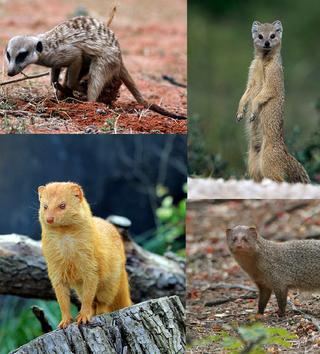
A mongoose is a small terrestrial carnivorous mammal belonging to the family Herpestidae. This family is currently split into two subfamilies, the Herpestinae and the Mungotinae. The Herpestinae comprises 23 living species that are native to southern Europe, Africa and Asia, whereas the Mungotinae comprises 11 species native to Africa. The Herpestidae originated about 21.8 ± 3.6 million years ago in the Early Miocene and genetically diverged into two main genetic lineages between 19.1 and 18.5 ± 3.5 million years ago.

Grandidier's mongoose, also known as the giant-striped mongoose or Grandidier's vontsira, is a small carnivoran that lives only in a very small area of southwestern Madagascar, in areas of spiny forest vegetation. It is pale brown or grayish coloured, with eight wide, dark stripes on its back and sides. Grandidier's mongoose is larger than the related broad-striped Malagasy mongoose, G. fasciata, and its stripes are not as wide. The species is named after Alfred Grandidier.
Be the Creature is a TV series created by the Kratt Brothers. A wildlife series designed to immerse both the brothers and the viewers in the world of animals, unlike the brothers' previous works, Kratts' Creatures and Zoboomafoo, Be the Creature is oriented towards teens and adults. The brothers place themselves in the thick of the animal world, sometimes in high-intensity or dangerous situations. The series also features some graphic footage in an effort to portray life in the wild truthfully.
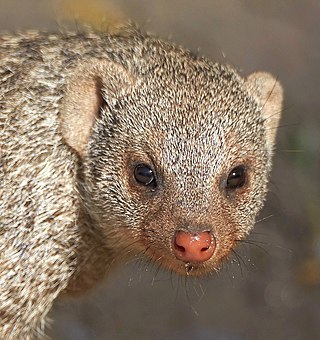
The banded mongoose is a mongoose species native from the Sahel to Southern Africa. It lives in savannas, open forests and grasslands and feeds primarily on beetles and millipedes. Mongooses use various types of dens for shelter including termite mounds. While most mongoose species live solitary lives, the banded mongoose live in colonies with a complex social structure.

Galidiinae is a subfamily of carnivorans that is restricted to Madagascar and includes six species classified into four genera. Together with the three other species of indigenous Malagasy carnivorans, including the fossa, they are currently classified in the family Eupleridae within the suborder Feliformia. Galidiinae are the smallest of the Malagasy carnivorans, generally weighing about 600 to 900 g. They are agile, short-legged animals with long, bushy ringed tails.

The bushy-tailed mongoose is a mammal in the family Herpestidae found in central Africa, from southern Kenya to central Mozambique.
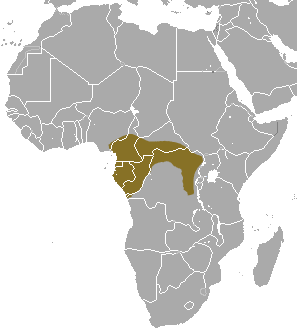
The black-footed mongoose is a mongoose species native to Central Africa, where it inhabits deep deciduous forests from eastern Nigeria to the southern Democratic Republic of the Congo. It has been listed as Least Concern on the IUCN Red List since 2008. It is omnivorous and feeds on ants, termites, Orthoptera, small rodents, frogs, lizards and fruits. It is mostly solitary and nocturnal.

The Ethiopian dwarf mongoose, also known as the desert dwarf mongoose or Somali dwarf mongoose, is a mongoose native to East Africa, particularly Ethiopia, Kenya, and Somalia.

The common dwarf mongoose is a mongoose species native to Angola, northern Namibia, KwaZulu-Natal in South Africa, Zambia and East Africa. It is part of the genus Helogale, along with the Ethiopian dwarf mongoose.

The Indian grey mongoose is a mongoose species native to the Indian subcontinent and West Asia. It is listed as Least Concern on the IUCN Red List.

The Indian brown mongoose is a mongoose species native to the Western Ghats in India and the western coast in Sri Lanka and introduced to Fiji. It is listed as least concern on the IUCN Red List.

The ruddy mongoose is a mongoose species native to hill forests in India and Sri Lanka.

The Liberian mongoose is a mongoose species native to Liberia and Ivory Coast. It is the only member of the genus Liberiictis. Phylogenetic analysis shows it is closely related to other small, social mongooses and that the banded mongoose is its closest relative.
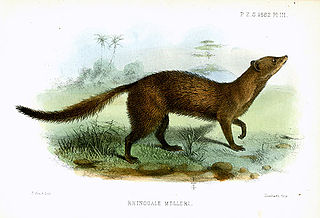
Meller's mongoose is a small brown mongoose native to savannas and woodlands of southeastern Africa. It is the only member of the genus Rhynchogale. The Meller's mongoose lives alone and is active at night, feeding on termites or other small insects and animals. While somewhat rare, it is adaptable and faces no serious threats. It is a member of the mongoose family (Herpestidae), a group of fox-like animals native to Asia, southern Europe, and Africa.

The broad-striped Malagasy mongoose or broad-striped vontsira is a species of Galidiinae, a subfamily of mongoose-like euplerids native to Madagascar. The species contains two known subspecies: Galidictis fasciata fasciata and Galidictis fasciata striata.
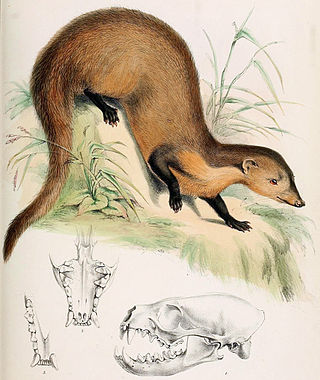
The collared mongoose is a mongoose species native to Borneo and Sumatra; its presence in the Philippines is uncertain. It is listed as Near Threatened on the IUCN Red List.

Helogale is a genus of the mongoose family (Herpestidae). It consists of two species and 12 subspecies:

Durrell's vontsira is a small, reddish-brown, fox-like mammal native to the island of Madagascar. Discovered in 2004, it lives only in the biodiverse wetlands of Lake Alaotra. Durrell's vontsira belongs to the family Eupleridae, a group of meat-eating, cat- or fox-like mammals found only on Madagascar. The species is closely related to the brown-tailed mongoose, with which it forms the genus Salanoia. The two are genetically similar, but morphologically distinct, and S. durrelli was described as a new species in 2010.

Urva is a genus comprising the Asian mongooses within the mongoose family Herpestidae. Species in the genus were formerly classified in the genus Herpestes, which is now thought to comprise exclusively African mongooses; phylogenetic evidence indicates that the Asian mongooses form a monophyletic group and had an Asian common ancestor. Urva forms a clade with Xenogale and Atilax, while Herpestes forms a clade with all other African mongoose species.